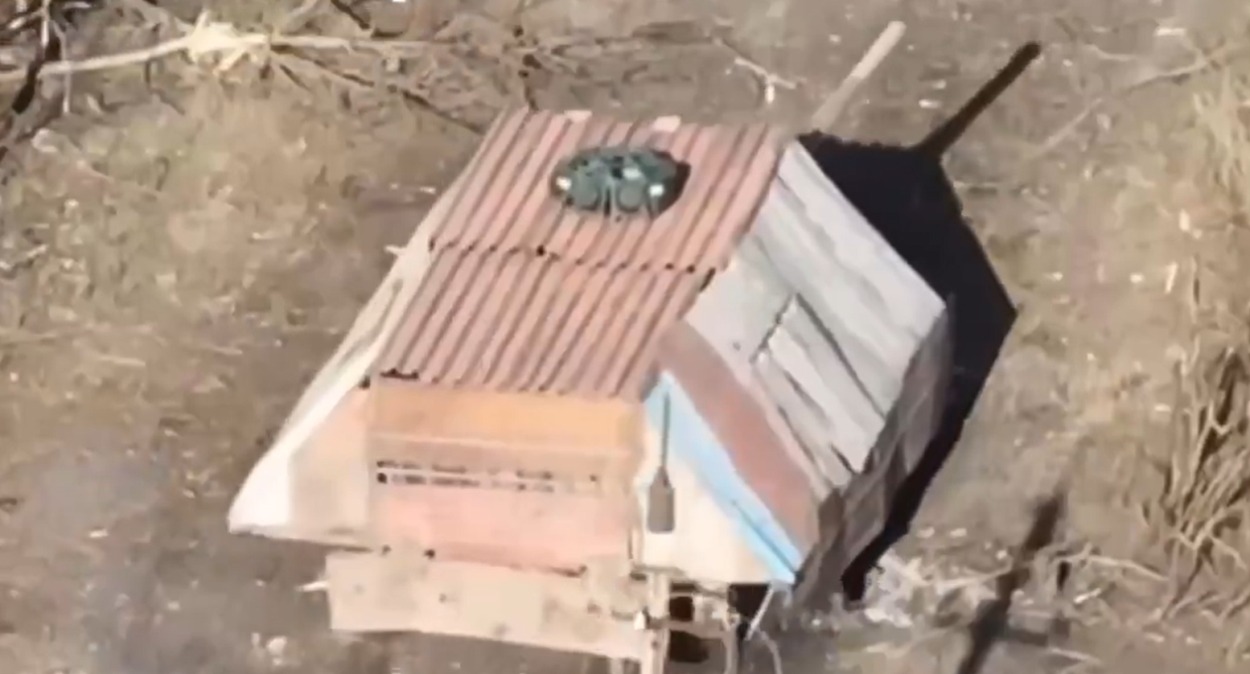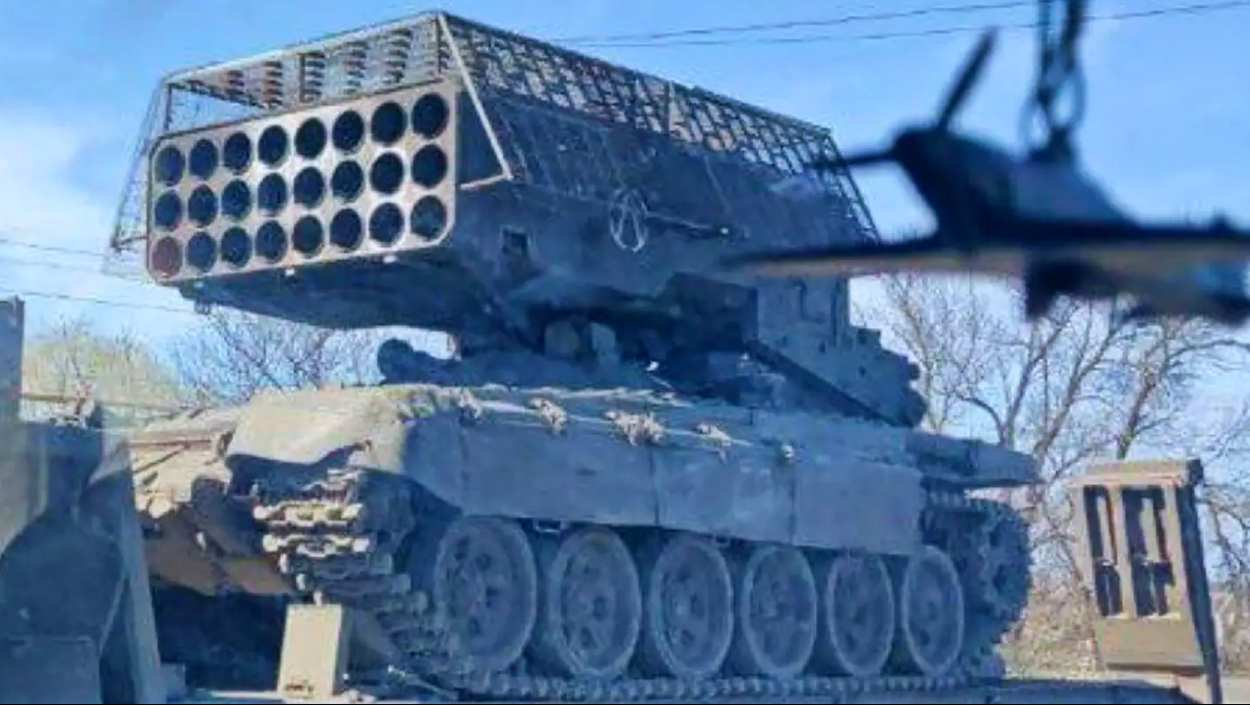Earlier this month, a Russian tank seemingly covered with a shed-like structure was spotted. Mocked by military watchers and pro-Ukrainian netizens as “bizarre,” this tank now sports electronic warfare equipment to thwart drone attacks.
Iran’s Su-35 Fighters, S-400 SAM’s Acquisition Would Make ‘Mission Impossible’ For Israel – US Media
The tank, which has since come to be known as the ‘turtle tank,’ is believed to be the latest Russian innovation in the theatre of war which has seen several new makeshift structures introduced on the battlefield. The turtle tank made the first appearance earlier this month somewhere near Krasnohorivka in the country’s eastern Donetsk region.
Although not officially confirmed, military bloggers believe the first example was a T-72 tank covered with a protective shed. The third and latest iteration of the tank was also spotted near Krasnohorivka. Earlier, it was assumed that the first example was the only one in the Russian arsenal, but at least three have been spotted in Ukraine so far.
The third and latest example has the largest shed covering and is equipped with an eight-antennae omnidirectional counter-drone electronic warfare (EW) jammer. These protected tanks are designed to counter drone strikes, particularly from highly maneuverable first-person view (FPV) drones that have been extensively deployed by the Ukrainian forces.
The main purpose of the jammers is to disconnect a drone from its operator, if any, and stop it from sending data, including video feeds. This can be particularly problematic for operators of FPV drones with warheads, as they depend on the video stream to guide the drone to its intended target.
Video of an armored assault by Russia's 5th Motorized Rifle Brigade on Krasnohorivka, and another appearance of a tank with a massive counter-FPV shelter and EW jammer, which continues to driving after a DPICM strike. It looks like the lead tank in the first video has a… pic.twitter.com/fQk3FN6ymx
— Rob Lee (@RALee85) April 16, 2024
These jammers disrupt GPS-guided targeting systems, and this interference results in kamikaze FPV drones veering off course and missing their targets. While Kyiv boasts considerable UAV capabilities, Russian EW has taken a toll on Ukrainian UAV operations, as previously reported by the EurAsian Times.
The shed-like structure on this so-called turtle tank has been called a new type of cope cage. With the proliferation of drone attacks on the battlefield, both sides have adopted different means of counter-drone strategies.
EurAsian Times had previously published a detailed piece on the use of another protective structure called ‘cope cages’ by Russia to protect the expensive battle tanks and armored vehicles against Ukrainian drone attacks.
Despite Russia pegging its hope on them, these ‘cope cages’ have had limited utility on the battlefield. Several videos posted on social media have shown Russian tanks with cope cages installed on them burning after a drone strike.
With the highly agile FPV suicide drones flying at shallow angles under the cages and even into vehicle openings, Russia has turned to larger and more intricate protective structures, as seen in these new turtle tanks.
what we thought would be modern warfare: Railguns, directed energy weapons, plasma protection fields
actual modern warfare: turtle tank pic.twitter.com/QGzZp3ACbw
— vodka chicken parm (@IdahoBones) April 17, 2024
Pro-Ukrainian military watchers, however, have dismissed these turtle tanks as a bizarre attempt at innovation. The first turtle tank was reportedly destroyed when Ukrainian forces attacked the warehouse where it was parked. A second iteration appeared a few days later at an unknown location, and its current status is unknown.
The third example of the turtle tank has a visibly larger shed than the other two. Images of the new device sparked confused responses on social media, with some sharing pictures of a medieval siege engine and the visor of a Darth Vader helmet being snapped off in response. The tank has also been compared to a bulldozer by pro-Ukrainian bloggers.

Could Be Effective Despite Limitations – Experts
Military watchers have noted that since the shed-like structure covers the entire tank, it restricts its operations by limiting its situational awareness and the mobility of its turret.
Indian Army veteran Lt Col J.S. Sodhi (retd) told EurAsian Times, “Russia fielding Turtle Tanks in its war with Ukraine is a flawed decision because of three reasons. One, the roof-like shed on the tank will hinder the 360-degree movement of the turret of the tank, which in turn will restrict the firepower of the tank. Two, the large thermal signature that the tank will have because of this contraption will make it easier to detect and, hence, more vulnerable to destruction by anti-tank missiles. Three, the increased weight of the tank due to this innovation will impede the mobility of the tank.”
In contrast, some other experts and social media bloggers observed that the electronic jammer-equipped turtle tank could lead an armored column to assault enemy positions without being engaged by a Ukrainian drone. Unless these EW jammers are neutralized, the Russian tank assault will proceed smoothly.
The famous Tsar-tank, the T-72, equipped with a roof from a house, from the 5th Brigade of the Armed Forces of the Russian Federation 🇷🇺 reached the center of Krasnohorivka and safely returned.#Ukraine #StandWithUkraine #NATO #Russia #WWIII #Krasnohirivka pic.twitter.com/IKHCYYNcLt
— Chronology (@Chronology22) April 16, 2024
When asked if these structures were that bizarre, Indian Army veteran Col.Rajendra Bhaduri told EurAsian Times, “From the videos and photos, it looks like some lead tanks have been field modified with a variation of the “cope cage.”
From the videos, it looks like, for all practical purposes, this modification is working. The tanks went through without damage. Initially, people had joked about cope-cages, but now even the Israelis and Ukrainians have put them on their Merkavas in the present Palestinian conflict. Though such modifications are temporary measures and not foolproof, their immediate effectiveness becomes useful.”
Interestingly, a netizen wrote on the social media site ‘X’ that if a stupid innovation is useful, it is not stupid.

Military expert and Russian commentator Big Serge put it in perspective, saying: “The field of vision and rotation for the turret would be impeded, but there are theoretically two major advantages of the roof shed. First, the strange silhouette could prevent automated ISR from identifying it as a tank and so serve as a form of camouflage. Secondly, the shed would serve as a sort of outer screen that could protect the tank from shaped charge warheads by causing the warhead to detonate prematurely outside the tank’s armor.”
This becomes especially significant when seen in the light of Kyiv’s Defense Ministry saying, “Russian tanks are Ukrainian FPV drones’ “favorite targets.”
- Contact the author at sakshi.tiwari9555(at)gmail.com
- Follow EurAsian Times on Google News




